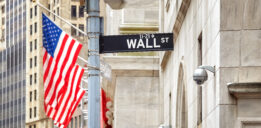Blame Liberals or Trump, But We’re on the Verge of a Global Financial Crisis
There may be more to the Dow Jones’s dramatic two-day 1,300-point drop than concern over higher interest rates and 10-year Treasury yields. The sheer scope and timing of the market correction suggests that there’s more than just a global financial crisis to worry about.
This could have something to do with the date. There’s always something in the air in October that has Wall Street folks concerned.
Could it be memories of 1929 or 1987?
What if elements in the political establishment and their Wall Street and Silicon Valley millionaire class allies were manipulating the market forces to erode any support President Donald Trump still enjoys?
After all, they tried the same with the Brett Kavanaugh nomination to the Supreme Court, and with Stormy Daniels, and with “Russiagate.”
Still, no matter how flimsy or scrupulous the evidence, Trump has always emerged unscathed.
If at First You Fail…
The strong economy and the performance of the stock market explain why all these efforts, despite millions of dollars and hours of mainstream media coverage, have failed.
As the old saying goes (attributed to 19th-century British educational writer William Edward Hickson), “If at first you don’t succeed, try, try, try again.”
They certainly are trying again. This time, the Democrats (and some Republicans) are not pulling any punches; they’re going after the very source of Trump’s legitimacy.
And they’re not afraid to trigger a global financial crisis to win back control of Congress. That will give them the numbers to impeach Trump.
A Financial Crisis Seems Like a Small Price to Pay to Stop Republicans
This is not merely my impression.
Pepe Escobar, a well-known journalist with impeccable credentials, who enjoys access to sources in lofty positions in Washington and Wall Street, suggested as much in a recent social media post.
EXCLUSIVE – BREAKING NEWS I got this from an exclusive list I'm part of which includes some pretty heavy-hitters in…
Posted by Pepe Escobar on Thursday, October 11, 2018
It would not be difficult to achieve a market crash big enough to cause a financial crisis-like panic. What Escobar describes as “premium sellers” have enough monetary strength to sell big chunks of top-shelf assets that buyers like.
The algorithms of the electronic trading systems then magnify the effects. That’s why investors cannot simply dismiss the market’s drop on October 10 and 11 as a mere “flash crash.”
But what if I were wrong about the mere possibility, let alone the insinuation, that a Washington establishment-Silicon Valley “clique” was behind this?
Would that, then, overturn the very notion that the United States is closer to another monetary disaster than it is to yet more Dow Jones records in 2018 and 2019?
The answer is no. A series of factors have already introduced themselves, pointing to the probability that a global financial crisis is around the corner, whether or not anyone is manipulating stocks for political aims.
So it’s time to get the umbrella out, like Wylie Coyote, and make sure it’s strong enough to protect you from more than autumn rains.
A Massive Boulder Is About to Land on Wall Street
The warnings of a financial crisis come from within and without. The International Monetary Fund (IMF) believes the world economy is going to grow at a slower pace than previously expected.
Now, you may be right in doubting that assessment. Economists have generally—and by that, I mean more than 99% of the time—not been able to pinpoint a recession.
But this time, there’s plenty of logic to back up the expectation of slower growth. The U.S. is still the world’s largest economy, and it will retain that heavyweight title for a decade or two to come.
So there’s no need to even toss a coin.
When America imposes tariffs on a wide variety of goods, from essential raw and processed materials like aluminum and steel to manufactured goods, breaking up the globalized trading order built up for over three decades, you can’t rule out any (negative) repercussions.
Besides, Trump himself has betrayed his own fears about the economy.
The president believes that the Federal Reserve’s interest rate hikes have pushed the U.S. dollar to a dangerous high, which can only result in a wider trade deficit.
The irony isn’t lost on those who have been warning about this for months now.
Trump Should Blame Himself for the Fed’s Rate Hikes
Trump has only himself to blame for the dollar’s climb and the precarious scenario it has created for the U.S. economy.
By the way, one of those policies is the tax reform itself, allowing large corporations to post a flood of favorable earnings growth statistics, which won’t have any chance of repeating in 2019.
The tax cuts would have had a less dramatic, yet more sustainable (in the long term) effect had they targeted the lower and middle class instead of favoring businesses, which got the biggest cuts.
Now the Fed feels compelled to fulfill its double mandate of controlling unemployment and keeping inflation below the threshold of tolerance (usually, two percent per annum).
It’s unusual for presidents to comment on the Fed’s monetary policy. It’s not unprecedented.
Indeed, the tradition of not interfering started with Bill Clinton. Nevertheless, when presidents do interfere, such as Richard Nixon did, it can cause problems.
The Nixon Precedent
The example is remarkable for its similarity to the present problem—social turmoil and all. Ahead of the 1972 election, Richard Nixon wanted to secure a second term by presenting Americans going to the polls the image of a strong U.S. economy.
He replaced Fed Chair William McChesney Martin with Arthur Burns. Burns was expected to keep interest rates low to curb potential unemployment. (Source: “An ugly economic lesson from the Nixon era proves why Trump’s criticisms of the Fed are so worrying,” Business Insider, July 20, 2018.)
Unfortunately for Nixon, apart from the eventual Watergate scandal, which would send him to early retirement in California, the decision to keep rates low combined with the oil crisis after the 1973 Arab–Israeli War (the Yom Kippur War), resulting in stagflation.
That stagflation produced a period of low growth, a protracted recession that hampered Ford and Carter, ushering in Reagan’s “trickle-down economics” era in the 1980s.
And as for Trump’s main point that the interest rates are increasing the trade deficit, he’s absolutely correct. They are. But he can easily identify the person responsible for this.
All he must do is pull a play from the Michael Jackson playbook and look at the man in the mirror.
The U.S. Economy Has Grown Too Much and Too Fast
Trump’s tax cuts have pushed the U.S. economy way ahead of all its nearest competitors—at least as far as corporate earnings are concerned in 2018.
In doing so, they have unduly strengthened the dollar, offsetting the effect of the tariffs.
The dollar’s strength relative to all other currencies—including the euro, which is almost at par after years of being some 15%-25% more valuable—means that Americans’ appetite for imported goods is as voracious as ever.
If Europeans can’t afford to buy those “Mercedes” and “BMW” cars, not to mention “Ferrari” and “Porsche,” there are plenty of Americans who can—and are.
Moreover, Trump’s foreign policy has done little to reduce the upward pressure on the oil price. Trump has complained about that as well—unsurprisingly, American voters do care about the price of gas at the pump—ahead of the November mid-term vote.
Threatening Iran with a regime change, having U.S. Ambassador to NATO Kay Bailey Hutchison threaten to take out Russian nukes (in Russia)…twice, and pontificate that the Chinese have been living too well isn’t going to win Trump the Nobel Peace Prize. (Source: “Trump says he could do ‘a lot more’ on China trade: Fox,” Reuters, October 11, 2018.)
Whether induced by a cabal of Wall Street and Washington anti-Trump billionaires or not, Trump’s own policies have created the conditions for a financial crisis.
Certainly, Trump has set the stage for an acceleration of economic and financial strength. But, those same policies combined with an erratic and disruptive foreign policy have also generated considerable uncertainty.
And if there’s one thing Wall Street doesn’t like, it’s uncertainty.






